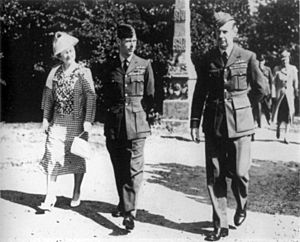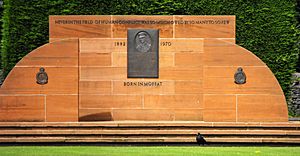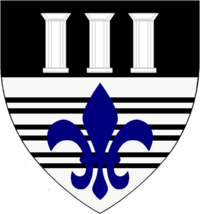Hugh Dowding facts for kids
Quick facts for kids
The Lord Dowding
|
|
|---|---|
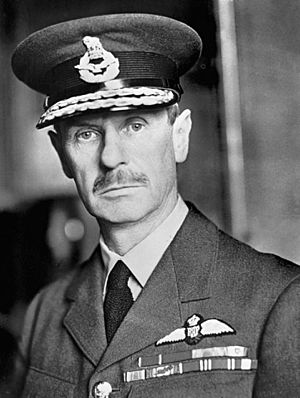
Lord Dowding
|
|
| Birth name | Hugh Caswall Tremenheere Dowding |
| Nickname(s) | Stuffy |
| Born | 24 April 1882 Moffat, Scotland |
| Died | 15 February 1970 (aged 87) Royal Tunbridge Wells, England |
| Allegiance | United Kingdom |
| Service/ |
British Army (1900–18) Royal Air Force (1918–42) |
| Years of service | 1900–1942 |
| Rank | Air Chief Marshal |
| Commands held | RAF Fighter Command (1936–40) Air Member for Research and Development (1935–36) Air Member for Supply and Research (1930–35) Fighting Area, Air Defence of Great Britain (1929–30) RAF Transjordan and Palestine (1929) No. 1 Group (1920–22) No. 16 Group (1919–20) No. 16 Squadron (1915–16) |
| Battles/wars | First World War Second World War |
| Awards | Knight Grand Cross of the Order of the Bath Knight Grand Cross of the Royal Victorian Order Companion of the Order of St Michael and St George Mentioned in Despatches |
| Spouse(s) |
Clarice Maud Vancourt
(m. 1918; died 1920)Muriel Whiting
(m. 1951) |
| Children | 1 |
Air Chief Marshal Hugh Caswall Tremenheere Dowding, 1st Baron Dowding (24 April 1882 – 15 February 1970) was a very important officer in the Royal Air Force (RAF). He was the leader of RAF Fighter Command during the Battle of Britain. Many people believe he played a key role in defending Britain. His actions helped stop Adolf Hitler's plan to invade Britain during World War II.
Dowding was born in Moffat, Scotland. He started his military career in the British Army in the early 1900s. Later, he joined the Royal Flying Corps at the start of the First World War. He became a fighter pilot and then led No. 16 Squadron RAF. Between the two World Wars, he held several important positions in the RAF. In July 1936, Dowding became the chief of the new RAF Fighter Command.
During the Second World War and the Battle of Britain, Dowding's Fighter Command successfully defended the UK. They fought off attacks from the German air force, known as the Luftwaffe. This success was thanks to Dowding's careful planning and smart use of RAF resources. He created a special air defence system called the Dowding system. Later, he had disagreements with other officers about new fighting tactics. This led to him being replaced in November 1940.
Dowding retired from the RAF in July 1942. In June 1943, he was given the title of a peer, becoming Baron Dowding. After retiring, he became interested in Spiritualism, Theosophy, and animal rights. He passed away on 15 February 1970, when he was 87 years old.
Contents
Early Life and Training
Hugh Dowding was born at St Ninian's School, Moffat in Moffat, Scotland. His father was a teacher. Dowding went to St Ninian's School and Winchester College. He then trained at the Royal Military Academy, Woolwich. On 18 August 1900, he became a second lieutenant in the Royal Garrison Artillery.
Military Career Beginnings
Dowding became a lieutenant on 8 May 1902. He served with the Royal Garrison Artillery in places like Gibraltar, Ceylon, and Hong Kong. In 1904, he was sent to India. After returning to the UK, he studied at the Staff College, Camberley in 1912. He was promoted to captain on 18 August 1913.
Dowding became very interested in flying. He earned his pilot's license on 19 December 1913. He then went to the Central Flying School and earned his wings. In August 1914, he joined the Royal Flying Corps (RFC) as a pilot with No. 7 Squadron RAF.
First World War Service
Dowding moved to No. 6 Squadron RAF in October 1914. After a short time as a staff officer in France, he became a Flight Commander. He led flights first with No. 9 Squadron RAF and then again with No. 6 Squadron. In March 1915, he became the commanding officer of the Wireless Experimental Establishment. In July 1915, he took command of No. 16 Squadron RAF in northern France.
After the Battle of the Somme, Dowding disagreed with General Hugh Trenchard, the RFC commander. Dowding believed pilots needed more rest. In January 1916, he returned to England. He was promoted to temporary lieutenant colonel and given command of 7 Wing. He later commanded 9 Wing in June 1916. He continued to rise in rank and command different training brigades. On 1 January 1919, he was recognized for his service.
Between the World Wars
On 1 August 1919, Dowding received a permanent position in the RAF as a group captain. He commanded different groups, including No. 16 Group RAF and No. 1 Group RAF. He helped organize annual air shows at Hendon. He was promoted to air commodore on 1 January 1922. He later served as chief staff officer in Iraq.
Dowding was also a skilled skier. He won the first ever National Slalom Championship. He was also president of the Ski Club of Great Britain for a time.
In May 1926, Dowding became the director of training at the Air Ministry. He was promoted to air vice-marshal on 1 January 1929. He then became Air Officer Commanding Fighting Area, Air Defence of Great Britain. In September 1930, he joined the Air Council. Here, he helped approve the safety certificate for the R101 airship. He later felt he should have been more careful with this decision.
This period saw fast improvements in aircraft design. People also worried about another major war. Dowding, though not a scientist, was very good at understanding new technologies. He was promoted to air marshal on 1 January 1933.
In July 1936, Dowding became the commanding officer of the new RAF Fighter Command. He did not agree with the idea that "The bomber will always get through". He created and oversaw the "Dowding system" for air defence. This system combined:
- Radar: Dowding was one of the first to see how useful radar could be.
- Human Observers: People from the Royal Observer Corps filled gaps in radar coverage. Early radar couldn't always tell how high enemy planes were flying.
- Raid Plotting: Tracking enemy aircraft movements.
- Radio Control: Guiding RAF planes using radio.
This entire network was connected by special telephone cables buried deep underground for protection. The main control center was at RAF Bentley Priory. This system later became known as Ground-controlled interception (GCI).
Dowding also made sure the RAF got modern aircraft before the war. These included the powerful Spitfire and Hurricane planes. He also fought to have bullet-proof windshields installed in fighter planes. He was promoted to air chief marshal on 1 January 1937.
Second World War: Battle of Britain
Dowding was supposed to retire in June 1939, but he was asked to stay because of the growing tensions before the war. He continued to serve through the Battle of Britain until November 1940. In 1940, Dowding, who was nicknamed "Stuffy" because he seemed serious, did not want to risk his planes and pilots to help Allied troops in the Battle of France. He and his superior, Sir Cyril Newall, refused requests from Winston Churchill to send valuable squadrons to France.
When the Allied forces in France were defeated, Dowding worked closely with Air Vice-Marshal Keith Park. Park commanded 11 Fighter Group. Together, they organized air cover for the evacuation of British troops from Dunkirk.
During the summer and autumn of 1940, in the Battle of Britain, Dowding's Fighter Command successfully fought off attacks from the Luftwaffe. His main contribution was managing resources behind the scenes. This included getting replacement aircraft and air crew. He also kept a large reserve of fighters ready. He let his commanders on the ground manage the daily battles.
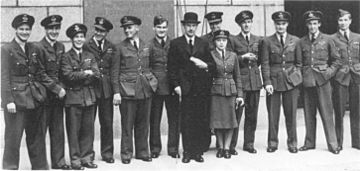
Dowding was known for being humble and sincere. Fighter Command pilots felt that Dowding cared about them. He often called his "dear fighter boys" his "chicks." His own son, Derek, was one of these pilots. Because of his excellent preparation of Britain's air defences and his careful management of resources during the battle, Dowding is widely seen as the reason Britain won the Battle of Britain.
Dowding's removal from command has been linked to disagreements over tactics. Some officers supported the "Big Wing" tactic, which involved using large groups of fighters. Dowding preferred his existing strategy. Another reason for his removal was the difficulty in stopping German nighttime bombing raids, known as the Blitz. There was a lot of public pressure to do something about these raids. Dowding had plans for improving night defence, but they needed time to develop.
On 8 October 1940, Dowding was further honored. He unwillingly left his command on 24 November 1940. He was replaced by Sholto Douglas, who supported the "Big Wing" idea. Churchill tried to make this easier for Dowding by sending him to the United States. There, he was in charge of getting new aircraft for Britain.
His book, Twelve Legions of Angels, was not allowed to be published in November 1941. The British Government thought it contained information that could help the Germans. The book was finally published in 1946 after the war ended.
Ministry of Aircraft Production
After leaving Fighter Command, Dowding went to the United States for the Ministry of Aircraft Production. He was very direct and sometimes made people unhappy. When he returned, he studied how to save manpower in the RAF. He then retired from the Royal Air Force in July 1942. On 2 June 1943, he was made a peer, becoming Baron Dowding of Bentley Priory.
Later Life and Interests
Later in his life, Dowding felt he had been treated unfairly by the RAF. He was not promoted to Marshal of the Royal Air Force.
He supported Robert Wright's book Dowding and the Battle of Britain. This book suggested that a group of "Big Wing" supporters had planned his removal from Fighter Command.
In 1951, Dowding helped start the Chapel of St George at RAF Biggin Hill. This chapel remembers fallen airmen.
Dowding and his second wife, Baroness Dowding, were both against vivisection (animal testing). In 1973, a group called the National Anti-Vivisection Society created the Lord Dowding Fund for Humane Research in his honor.
Spiritualism and Animal Rights
In his retirement, Dowding became very interested in Spiritualism. He wrote books and gave talks on the subject. His first book, Many Mansions, was written in 1943. He also wrote Lychgate (1945), The Dark Star, and God's Magic. He did not follow traditional Christianity. Instead, he joined the Theosophical Society, which believes in reincarnation. He wrote about meeting spirits of dead "RAF boys" in his dreams.
Dowding became a vegetarian because of his beliefs as a theosophist and spiritualist. He believed that animals would still be killed for human needs for a long time. So, he asked the House of Lords to ensure animals killed for food were treated humanely. He also believed in fairies, thinking they were important for plant growth.
Death and Legacy
Dowding passed away at his home in Royal Tunbridge Wells, Kent, on 15 February 1970. He was 87 years old. His body was cremated, and his ashes were placed in the Royal Air Force chapel in Westminster Abbey. Dowding's son, Derek, inherited his title.
Personal Life
Dowding married Clarice Maud Vancourt on 16 February 1918. She had a daughter from a previous marriage. Together, Hugh and Clarice had one son, Derek Hugh Tremenheere. Clarice died in 1920. Dowding's sister, Hilda, helped him raise the two children.
Dowding married Muriel Whiting on 25 September 1951. They did not have any children together.
Media Portrayals
Hugh Dowding has been shown in several films:
- In the 1956 film Reach for the Sky, he was played by Charles Carson.
- In the 1969 film Battle of Britain, he was played by Laurence Olivier. Olivier himself had been a pilot in World War II. During filming, Dowding, who was 86 and in a wheelchair, visited the set. Olivier told Dowding he had been "pretending to be you" and was "making an awful mess of it." Dowding replied, "Oh, I'm sure you are," which made everyone laugh.
- In the 2017 film Darkest Hour, Dowding was played by Adrian Rawlins.
- In the 2018 film Hurricane: 303 Squadron, Dowding was played by Nicholas Farrell.
Honours and Tributes
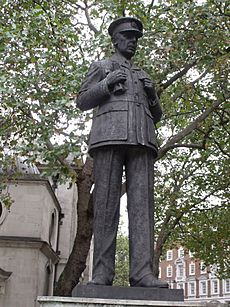
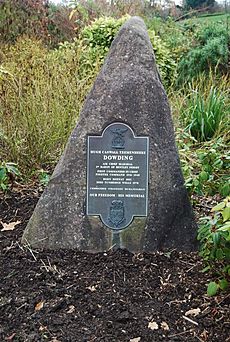
A statue of Dowding stands outside St Clement Danes church in Strand, London.
Other monuments to Dowding can be found in Station Park in Moffat, his hometown. There is also a memorial in Calverley Gardens in Tunbridge Wells, where he died. The Royal Air Forces Association bought his birthplace, St Ninian's School. It was renamed Dowding House and now provides housing for former RAF members or their families.
The Dowding Centre at RAF Boulmer is named after him. A special green plaque was placed at his former home in Southborough on 6 May 2012. Dowding Place in Stanmore is also named after him. A train built in 1946 was named Lord Dowding in his honor.
|
See also
 In Spanish: Hugh Dowding para niños
In Spanish: Hugh Dowding para niños
- List of animal rights advocates


